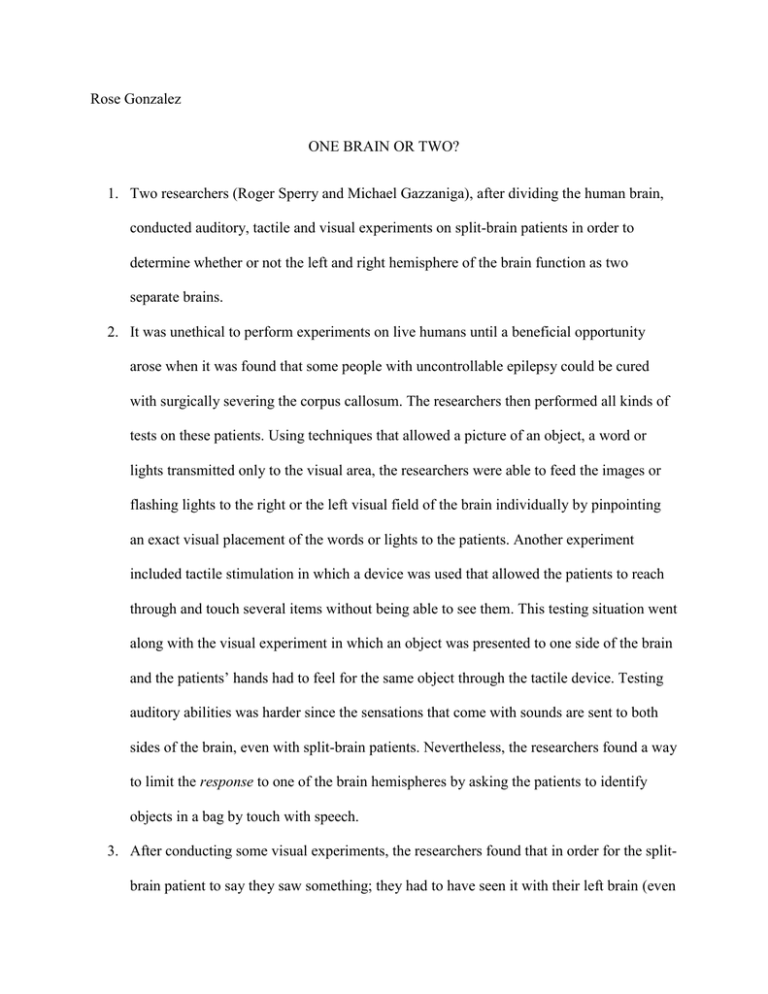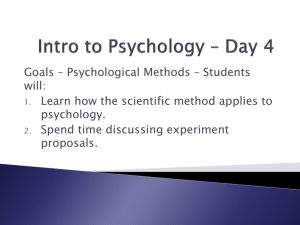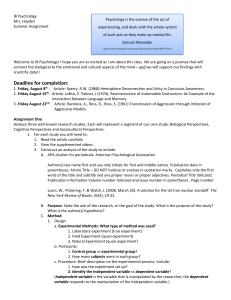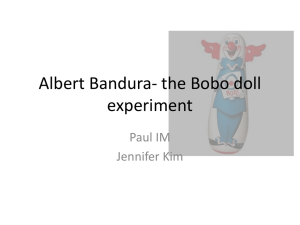Rose Gonzalez ONE BRAIN OR TWO? Two researchers (Roger
advertisement

Rose Gonzalez ONE BRAIN OR TWO? 1. Two researchers (Roger Sperry and Michael Gazzaniga), after dividing the human brain, conducted auditory, tactile and visual experiments on split-brain patients in order to determine whether or not the left and right hemisphere of the brain function as two separate brains. 2. It was unethical to perform experiments on live humans until a beneficial opportunity arose when it was found that some people with uncontrollable epilepsy could be cured with surgically severing the corpus callosum. The researchers then performed all kinds of tests on these patients. Using techniques that allowed a picture of an object, a word or lights transmitted only to the visual area, the researchers were able to feed the images or flashing lights to the right or the left visual field of the brain individually by pinpointing an exact visual placement of the words or lights to the patients. Another experiment included tactile stimulation in which a device was used that allowed the patients to reach through and touch several items without being able to see them. This testing situation went along with the visual experiment in which an object was presented to one side of the brain and the patients’ hands had to feel for the same object through the tactile device. Testing auditory abilities was harder since the sensations that come with sounds are sent to both sides of the brain, even with split-brain patients. Nevertheless, the researchers found a way to limit the response to one of the brain hemispheres by asking the patients to identify objects in a bag by touch with speech. 3. After conducting some visual experiments, the researchers found that in order for the splitbrain patient to say they saw something; they had to have seen it with their left brain (even though both halves were equally skilled in visual perception) because the center for speech is located in the left hemisphere. For the tactile experiments, the researchers found that the patients had no problem identifying an object they had in the left or right hands even if they could not see the object. However, they could only verbally say it if the objects were in their right hand. When it came to their left hands holding the object, they could only prove they knew what it was in a nonverbal, gestural way. 4. A weakness could be the criticism by some people who believe the researchers were actually wrong and that the brain functions as a single, integrated structure while some of the strengths of the experiments include the new found knowledge of the human brain. We now know that the two halves of the brain have multiple specialized skills and functions. The left hemisphere specializes in math, speech, logic, writing and right hand touch while the right hemisphere specializes in recognizing faces, artistic activities, symbolic reasoning, perception, spatial relationships and left hand touch. 5. Since we have a better understanding of the specialized functioning of the brain, it is easier for victims of strokes or head injuries to get treated more efficiently. Sperry and Gazzaniga’s curiosity and determination to answer the popular question of whether or not the brain may actually be two separate mental functions caused many other questions and studies to emerge that resulted in new findings; such as the theory that one’s dominant hemisphere can lead them towards a specific interest or profession. 6. SEE AGGRESSION…DO AGGRESSION! 1. Albert Bandura and his associates, Dorothea Ross and Sheila Ross believed that aggression could be observed and imitated through a process called behavioral modeling. The experiment they performed involved children, some adults and a Bobo doll (an inflatable toy designed to bounce back when knocked over). The purpose of this experiment, that later became famously known as ‘the Bobo Doll Experiment’, was to expose the children to the adult models who would either act in aggressive or nonaggressive ways towards the dolls and see if the children would then imitate the models’ behavior. 2. The researchers were able to enlist the help of 36 boys and 36 girls, ranging in age from 3 to 6 years to participate in the experiment. The children were divided several times into groups with same-sex models and opposite-sex models then again into situations where the models would or wouldn’t act aggressively towards the Bobo doll. The children, after observing the adults, were then put in another room without the models to see how they’d react to the dolls. 3. The children who were exposed to the aggressive actions of the models imitated the exact violent behavior they observed. These findings from the experiment support Bandura’s behaviorist theory in which aggression is learned through observation learning. The experiment also proved that society’s views of aggression as a masculine-typed behavior made the influence stronger for boys who observed male models act violent. 4. A weakness of this experiment is that it could be considered unethical; having possibly made the children think that violence is permissible and later causing future complications with aggression. A strength could be that it was a controlled experiment (the genders of the children or models, the times the children observed the models, the behavior of the models etc...) making the predictions the researchers made prior to the experiment more accurate. 5. This experiment proved to be significant since it forced the U.S culture to open their eyes and become more conscious with the subject of television violence. It also led to more important experiments performed by Bandura. He later thought of a new theory that included reinforcements as a key component to children’s behavior. By testing out this theory using reinforcements and punishments, Bandura found that children imitated the aggressive behavior more when the models were rewarded and significantly less when the models were punished. 6. Personal experience-My mother babysits a bright 3 year old named Melanie who my family has known since she was about 4 months. Melanie and I are really close and we treat each other like sisters. Once I get home from school, she usually comes to my room and watches Dora while I do my homework. This one time I got into an argument with my brother when she was around and she sadly witnessed it all. She saw how angry I got and how I took my anger out by screaming into my pillow. Ever since then, whenever she gets punished and gets mad about it, she screams into the couch pillows in the living room. This proves that she learned to imitate my displacement of aggression. THANKS FOR THE MEMORIES! 1. Elizabeth Loftus believed that memory can in fact be distorted by other information from and after an event. Loftus’s research was performed by four main different experiments that involved participants watching films and answering questions about what they saw. Her research later became significant for court cases and situations when people had to remember traumatizing or important events. 2. The first experiment consisted of showing a small group of people a clip of a car accident that happened when a driver ran through a stop sign into oncoming traffic. The group was then divided in half with the first group being asked how fast the car was going when it ran the stop sign and the second was asked how fast the car was going when it turned right. The last question asked both groups if they saw a stop sign in the car accident and the results were significantly different. The second experiment involved a delayed memory test in which the participants saw a clip of a class being disrupted by 8 antiwar demonstrators. In this experiment, the participants were asked if the demonstrators were male but the actual number of demonstrators that were in the clip was altered in the question (to 12 for group 1 and 4 for group 2). The groups were then asked about a week later how many demonstrators there were in the film and each group had different answers ranging from 6 to 8. The third experiment tried to alter the participants’ memory of a clip by inserting false presuppositions of objects that were never in the film to begin with. The fourth experiment was quite similar to the third but instead with simply mentioning the object to alter the person’s memory when asked the same question in the near future. 3. The first experiment showed that in the first group, 53% of people said they saw a stop sign while in the second group only 35% of the participants confirmed they saw one. The second experiment proved how questions could be worded so they change the way one remembers basic characteristics of an event. The third and fourth experiment explained how one’s memory can be altered just by mentioning an object or situation that was never there or never happened, making the person believe otherwise. 4. Some weaknesses to Loftus’s research are how memory is not reliable, making the results for the research unreliable and that some people do not count for these types of theories since they might have issues with their hippocampus. A strength however could be that her research helps law enforcements bring justice to people falsely accused of crimes. 5. The significance of Loftus’s research is that it demonstrated how an eyewitness’s memory of an event can be manipulated by the mere wording of a question making their testimony and memory not as reliable as people would like to think. This significant finding saved some innocent people who were accused of horrible crimes and helped understand some other court cases better. More importantly, Loftus’s research proved that one’s memory can never be completely relied upon because it will almost always be reconstructed whether they strongly believe something happened a certain way or experienced a traumatic event. 6. When I was 4, my family decided it was time to move to another town. I remember feeling really upset because my best friend lived right next door to me. On my last day in town, we spent the day baking cookies together and when it was time for me to leave, it started to pour. However, when I bring that day up now, my mother says that it was cloudy but it never actually rained. Maybe I thought it did because of how gloomy I felt. HOW MORAL ARE YOU? 1. Lawrence Kohlberg, one of the most influential figures in the history of research of the formation of morality, believed that a child must reach certain stages of intellectual ability in order to understand and develop morality. He also believed that these stages are universal and always occur in the same order despite any individual environment, experience, or culture. The moral stages were as follows; the child… 1) Fears punishment by another 2) Is manipulated by rewards from another 3) Tries to live up to expectations to avoid disapproval by others 4) Recognizes and respects law and order without questioning social order 5) Develops community disrespect while continuing to obey law 6) Reaches self condemnation 2. Kohlberg’s theory of the formation of morality was experimented by giving children of various ages 10 hypothetical moral dilemmas to prove the children’s moral judgments progressed predictably by age (stage). 3. Findings 4. A weakness of the study was that it was experimented on mostly boys, which makes Kohlberg’s theory (that everyone goes through these stages) not as reliable. Another complication was that A strength of the experiment however..




